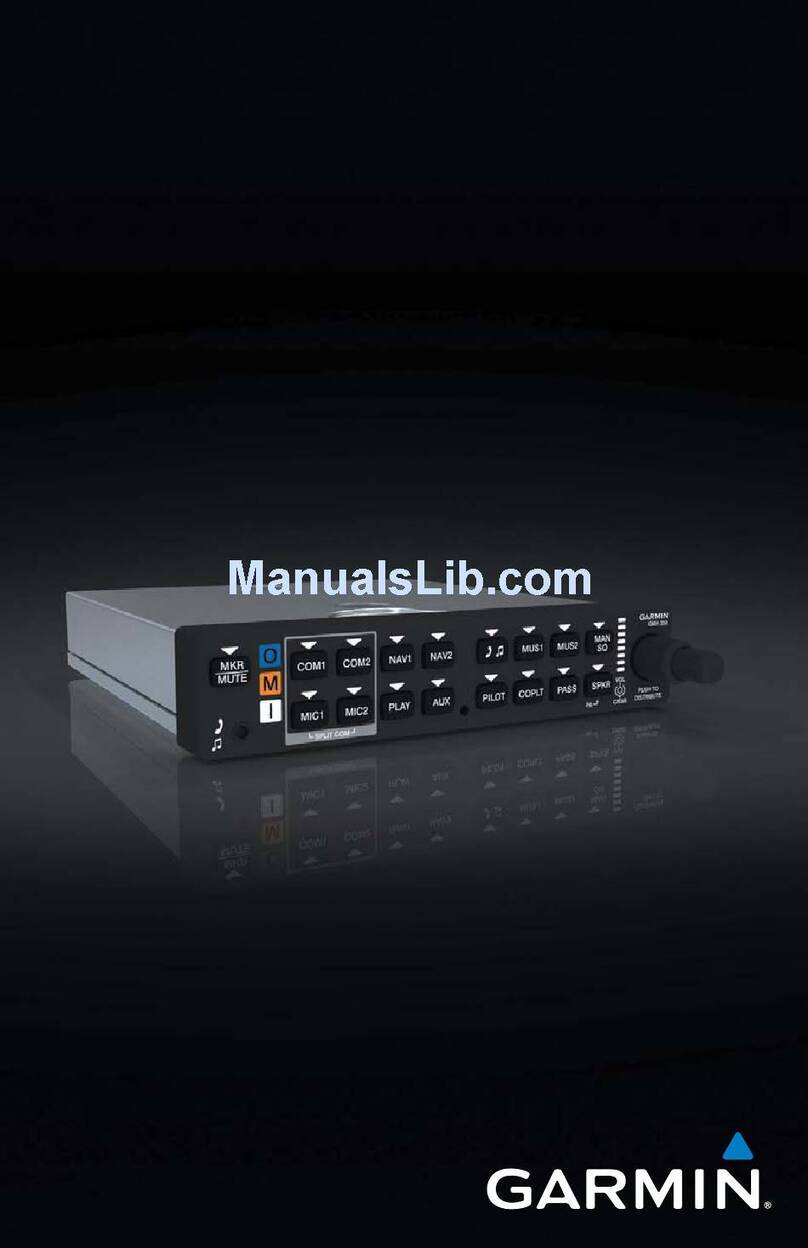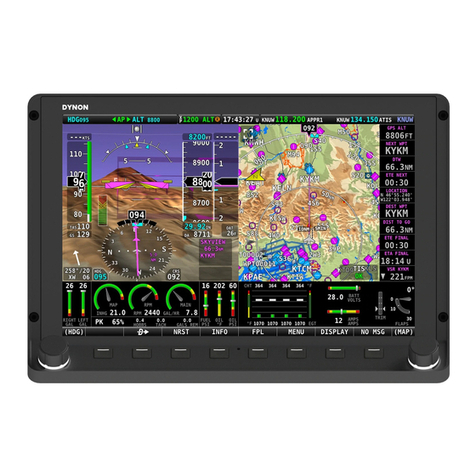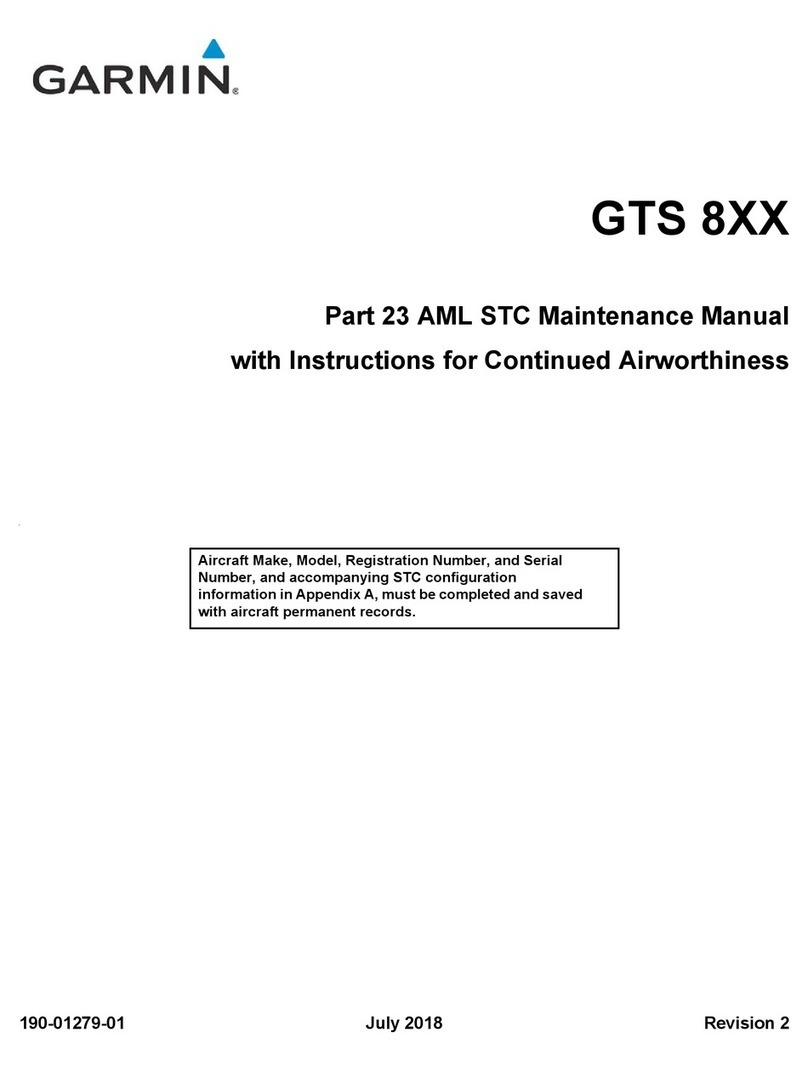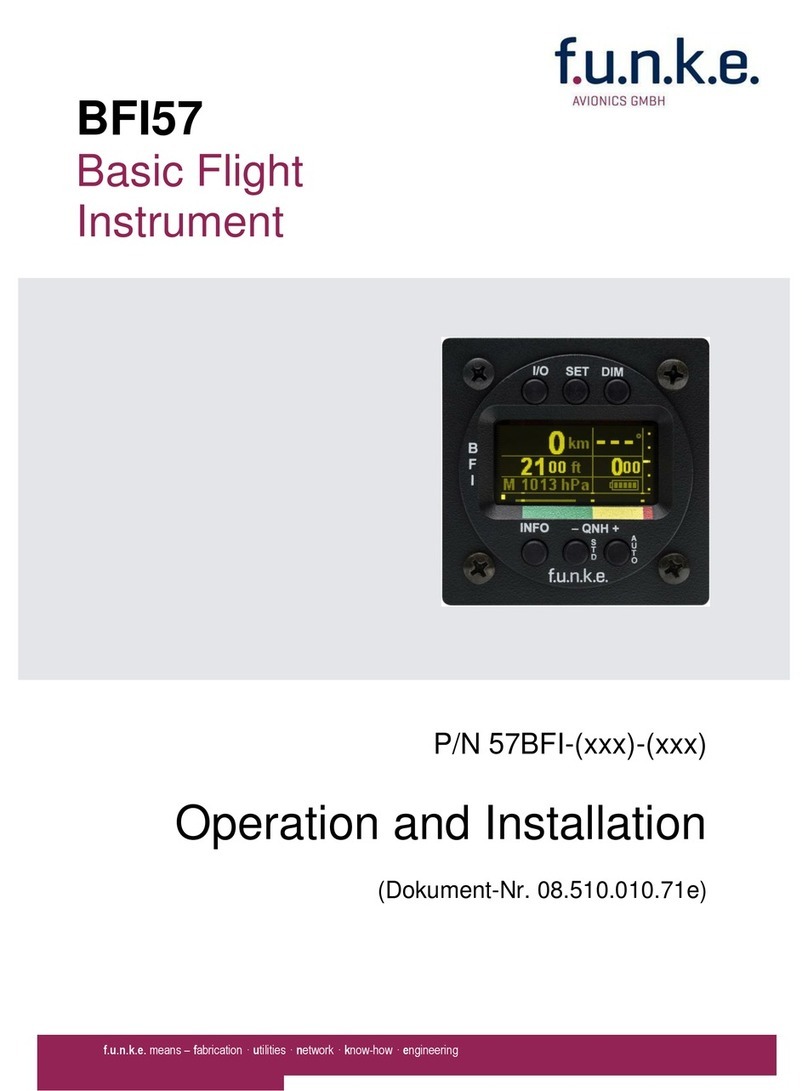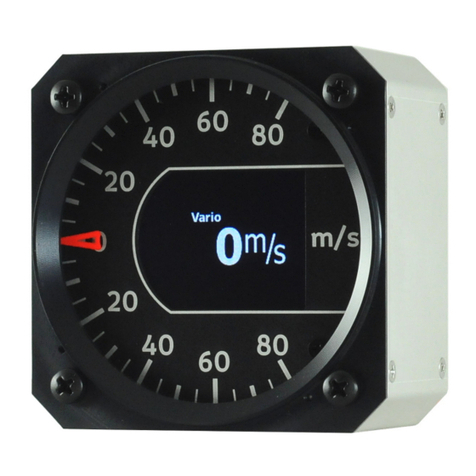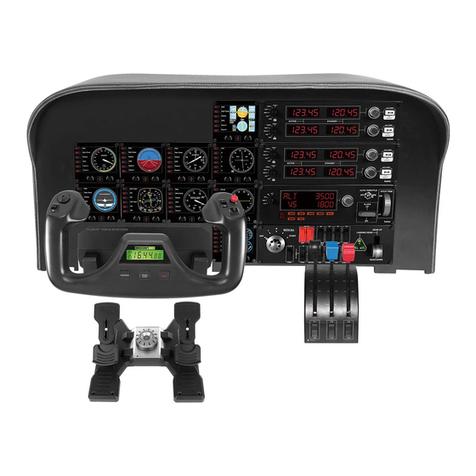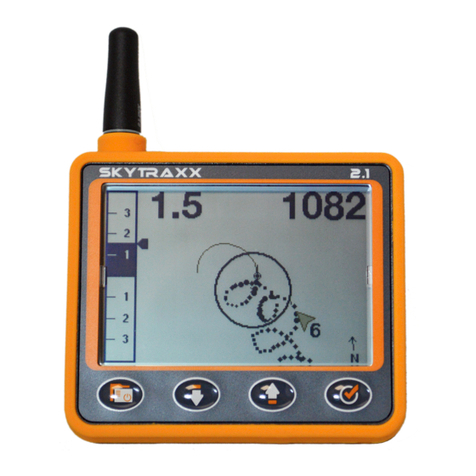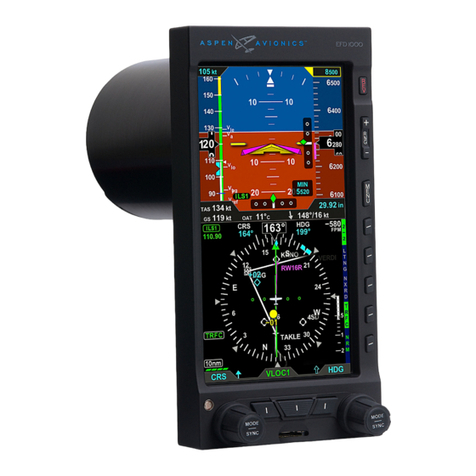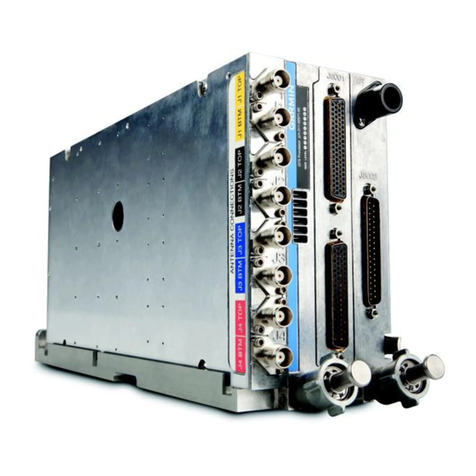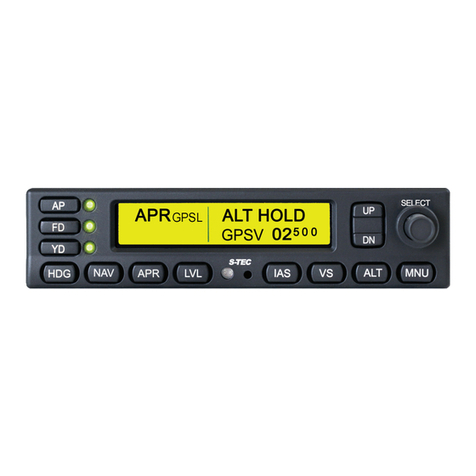FrSky RB-30 User manual

FrSky Electronic Co., Ltd.
RB-30/RB-40
Manual
Version 1.0

Introduction
The RB-30/RB-40 utilizes all the trusted attributes of the previous Redundancy Bus series along with adding new features
to meet the needs of an ever-growing range of users.
The upgraded redundancy hub
Previous redundancy bus models offered a dual-power with a dual-receiver design, the RB-30/RB-40 allows the user to use
a triple redundancy by adding a multiplex port (RX3 IN / SBUS Out) and uses a set of standard XT30/XT60 plugs which
provides a safe and efficient way to provide power.
Up to 24 PWM channels with overload protection
The RB-30/RB-40 supports connecting up to 24 high-voltage servos with overload protection added to each output channel.
Eight of the channels (CH1-8) are equipped with current sensors.
The diversified sensors
The RB-30/RB-40 is an extensive sensor module with a built-in gyroscope that supports model stabilizing functions and
includes other diversified telemetry feedback like the voltage, power consumption, altitude, and a lot more. It can be used
as an alternative to using a GR or S series receiver.
NFC Switch & Automatic data logging functions
The non-contact NFC switch is an external device that enables the power to be switched on/off on command without the
need to plug/unplug the battery connections. Once power is connected, the black-box function is automatically activated
and immediately starts recording the data.
Menu scroll button, LCD screen & CNC case (RB-40 Only)
The RB-40 features a display screen that is comparable in size to one found on the X-Lite series radio. Navigating and
configuring telemetry data is even more convenient thanks to the scroll button. Even considering all these features while
maintaining durability, the RB-40 weighs only 260 grams thanks to the hybrid design of carbon fiber and aluminum
materials.
Overview
NON-CONTACT
SWITCH
VBAT1 VBAT2
DUAL POWER TRIPLE RECEIVER
TRIPLE GUARANTEE
24 CHANNEL SERVO INTERFACE
VOUT1 VOUT2
RX1 IN
RX2 IN
RX3 IN
/SBUSOUT
S.PORT
RX1 S.P
RX2 S.P
Page 1 Page 2

•
RX1 S.P-connect to the S.Port of RX1
•
RX2 S.P-connect to the S.Port of RX2
•
S.Port-connect to the S.Port of FrSky products with S.Port
•
RX1 IN~RX3 IN-connect to the SBUS OUT Port of the receiver.
* The RX3 IN can be switched to S.BUS OUT by the script or the Scroll button or the Freelink App.
•
BATTERY INPUT1&BATTERY INPUT2-connectors for batteries
,
supply power for RB-30/RB-40 and connected receivers.
•
OUTPUT1&OUTPUT2: SBEC OUTPUT
, Continuous Current: 2*15A@5~8.4V (RB-30 ) / 2*30A@5~8.4V(RB-40)
External Blue LED
ON
OFF
State (Self-check)
In process
Completing
CH1~CH24
-connect up to 24 servos (PWM)
*CH24 is used for the external LED when enable the stabilization function.
Specifications
• Dimension: RB-30: 114.4*73.4*18.7mm
RB-40: 163.2*100*23.5mm
• Weight: RB-30: 100g / RB-40: 260g
• Power connector: RB-30: XT30 / RB-40: XT60
• Number of servos: up to 24
• Operating temperature: -20℃~75℃
• Recommended input voltage range: DC 11~26V
Features
•
Dual Power & Triple Receiver Guarantee
• High-voltage Servo Supported (Up to 24 PWM servos)
• Overload Protection on Each Channel
• Channel 1-8 with Current Detection
• Supports Stabilization Function with Built-in Gyroscope Sensor
• Multiple configuration methods (Lua script and FreeLink)
• Compatible with FrSky S.Port products
• Various S.Port Telemetry Feedbacks (Voltage,
Current, Power Consumption, etc.)
• Black Box Data Record Function
• Non-contact Switch (Optional)
• LCD Screen with Menu Scroll Button (
Only
RB-40)
• CNC Aluminum & Carbon Fiber Case (
Only
RB-40)
Page 3 Page 4
Layout: (take RB-30 for example)
Dual-Frequency System (2.4GHz ACCESS & R9 SERIES) with RB Device
* To use multi ACCESS receivers binding with the same ISRM module, please modify the UID for different receivers.
DUAL POWER TRIPLE RECEIVER
TRIPLE GUARANTEE
24 CHANNEL SERVO INTERFACE
RB-30 / RB-40
2
2
8/24CH Telemetry
R8 PRO
2
2
8/24CH Telemetry
R8 PRO
R9 Series Receiver
ACCESS Series Receiver
DUAL POWER TRIPLE RECEIVER
TRIPLE GUARANTEE
24 CHANNEL SERVO INTERFACE
Non-contact Switch
CH1
CH2
CH3
CH4
CH5/
CH6/SBUSOUT
SBUS
OUT
SBUS
IN
AIN2
6/16 CH Long Range & Telemetry
R9 S x
* User also can replace the R9 SX
with the R8 PRO.

Introduction about two battery power supply
The RB-30/RB-40 supports DC 11V~26V. When two batteries are inserted at the same time, the higher SBEC output will be
selected to power the device. The maximum continuous current is 30A.
If the voltages of two power SBEC supplies are same, power can be used from both supplies at the same time;
If the voltages of two power SBEC supplies are different, the power comes from the one with the higher voltage.
Application of batteries with different capacity, number of cells and chemistry type is allowed.
Please ensure output power on one of the two power supplies is no less than the maximum operation power of the
connected devices (servos, etc.), or insufficient power supply on the connected devices may occur.
The RB-30/RB-40 supports two SBEC outputs, DC 5-8.4V.
The output voltage can be adjusted by the script or the Scroll button or the Freelink App. The supply voltage of CH1~CH24
and RX1~RX3 comes from the highest voltage.
StabFunc. Enable
RX3 SBUS IN
Vout 1 Set 6.6V
Vout 2 Set 5.0V
Rx Protocol ACCESS
(RB-40)
* The Stabilization function can be enabled or disable by the script or the scroll button or Freelink APP.
* The RX3 SBUS IN can be switched to SBUS OUT by the script or the scroll button or Freelink APP.
Channel Mapping:
1. The RB-30/RB-40 PWM 1 outputs the RX1 CH1 in default, if RX1 CH1 is not normal, it will switch to output the RX2 CH1.
2. You can set the PWM output of RB-30/RB-40 from which RX channel.
Page 5
Ch17 Map 0 0 0
Ch18 Map 0 0 0
Ch19 Map 0 0 0
Ch20 Map 0 0 0
Ch21 Map 0 0 0
Ch22 Map 0 0 0
Ch23 Map 0 0 0
Ch24 Map 0 0 0
Ch 9 Map 9 9 9
Ch10 Map 10 10 10
Ch11 Map 11 11 11
Ch12 Map 12 12 13
Ch13 Map 13 13 13
Ch14 Map 14 14 14
Ch15 Map 15 15 15
Ch16 Map 16 16 16
* The Stabilization function should be disabled when you set the channel mapping.
Failsafe set:
The channel outputs the value you set when into Failsafe.
Ch 1 FailSafe 800
Ch 2 FailSafe 800
Ch 3 FailSafe 800
Ch 4 FailSafe 800
Ch 5 FailSafe 800
Ch 6 FailSafe 800
Ch 7 FailSafe 800
Ch 8 FailSafe 800
* You can set up it by the script or the Scroll button or Freelink APP.
Overcurrent protection and current detection & state monitor
CH1~CH8 is equipped with current detection sensor, which can detect current in real time. CH1~CH24 have overload
protection. RB-30/RB-40 also monitors the status of each interface in real time.
Ch 1 Curr 0.3A
Ch 2 Curr 0.0A
Ch 3 Curr 0.1A
Ch 4 Curr 0.0A
Ch 5 Curr 0.0A
Ch 6 Curr 0.0A
Ch 7 Curr 0.0A
Ch 8 Curr 0.0A
(RB-40)
Rx1 No Connect
Rx2 No Connect
Rx3 No Connect
Sport1 Not Connect
Sport2 Not Connect
(RB-40)
Vbat1 Volt: 16.0V
Vbat1 Curr: 0.3A
Vbat1 Powe: 46mAh
Vout1 Volt: 6.6V
Vbat2 Volt: 0.0V
Vbat2 Curr: 0.0A
Vbat2 Powe: 0mAh
Vout2 Volt: 0.1V
(RB-40)
Page 6
Caution: 1. Do not connect power supplies to CH1~CH24, S.PORT, RX1 S.P, RX2 S.P, RX1 IN ~RX3 IN.
2. Select the ACCESS/ACCST Rx Protocol before using it.
Ch 1 Map 1 1 1
Ch 2 Map 2 2 2
Ch 3 Map 3 3 3
Ch 4 Map 4 4 4
Ch 5 Map 5 5 5
Ch 6 Map 6 6 6
Ch 7 Map 7 7 7
Ch 8 Map 8 8 8
RB PWM1 RX1 CH1 RX2 CH1
RX3 CH1

If current overload, the affected servo output will be disconnected from the power supply while remaining servo outputs are
still powered.
The allowed continuous current output on CH1~CH24, S.PORT, RX 1IN, RX 2IN,RX3 IN is 5A. When the continuous current
is over 10A, the RB-30/RB-40 will activate overload protection immediately 23℃.
Temperature
23℃
50℃
70℃
Ihold (A) Itrip (A)
10.005.00
3.95
3.35
7.90
6.70
Display
OK
CHn / RXn_IN / SBUS_OUT / RX3_IN
Definition for Value
normal
CHn / RXn_IN / SBUS_OUT / RX3_IN overload
1.
All values above will be transmitted to FrSky radio system in real time
AccX/Y/Z—Accelerometer triaxial parameter
CH1A~CH8A—The current telemetry of CH1 ~CH8
RBnC:
total power usage of battery n
RBnV:
the voltage of battery n
RBnA:
the current of battery n
RBCS:
About the telemetry values:
Note
I
hold
means the maximum current passes through the device without tripping under the above three conditions.
I
trip
means the minumum current passing through the device will cause trip under the above three conditions.
Page 7 Page 8
2. When using SD logs function, if the RBCS has a non-zero value, such as 64, Convert 64 to binary 1000000,As you can
see from the table, the channel 7 overloader or Voltage less than 4V.
BitX
Bit n
(n≤15)
Definition for Value
0: channel n+1 normal
1: channel n+1 overloader or Voltage less than 4V
RBES: indication of CHN status.
Display
OK
CHn
Definition for Value
normal
CHn (n:17~24) overload
RBS:indication of receiver status.
Display
RX OK
RXn_FS
RXn_LOSTFRAME
RXn_PHYSICAL_CONNECTION _LOST
RXn_NO_SIGNAL
Definition for Value
normal
Receiver n Failsafe
Receiver n Lost frame
Receiver n Physical connection lost
Receiver n No signal

About the Stabilization function
Channels
Number of
channel
CH1
CH2
CH3
CH4
CH5
CH6
Corresponding parts
on the model
AIL 1
ELE 1
THR
RUD
AIL 2
ELE 2
Full name
Aileron
Elevator
Throttle
Rudder
Aileron
Elevator
Number of
channel
CH7
CH8
CH9
CH10&CH11
CH12
Corresponding parts
on the model
User-defined
User-defined
No mark
No mark
Full name
Gyro gain adjustment
Flight modes
Self-check activation switch
Page 9
Gyro gain adjustment of CH9: When the the value of CH9 is in the center, the gain is zero. The gain increases as the value
gets bigger. Until the value is ±100%, the gain reaches maximum.
Attention:
1. RB-30/RB-40 doesn't support hotplug. When RX1 or RX2 is replaced halfway, RB-30/RB-40 needs to be repowered
on.
2. Make sure both of the receivers output the same signal. For example,when S8R and X8R are used together, disable
Stab function on S8R, or they will output different signals.
3. RB-30/RB-40 will manage the telemetry of the two receivers automatically after connecting the devices. There’s no
need to disable the telemetry while binding RX1/RX2.
* Note: "RX3 SBUS IN" STATE.
Attentions
CH1~CH8 should be connected to the corresponding servos.
Set up your model and receiver
You need to complete calibration of Accelerometer about the six positions via the RB-30/RB-40.Lua/FreeLink APP firstly.
Step1: Connect your servos follow the channel list according to your model.
Step2: Set you radio follow the channel list.
Step3: Choose the Wing Type via the configuration tool (RB-30/RB-40.Lua/FreeLink APP).
Step4: Choose the AUTO LEVEL mode, check the model servo feedback.
Step5: Choose the manual mode, check servo feedback via transmitter.
Quick Mode
It supports stabilization mode and manual (six-axis off) mode and configured through CH10. What’s more, an urgent mode
is added to configure automatic level mode default through CH12. The precise configuration is given below.
Page 10
3. When using SD logs function. if the RBS has a non-zero value, such as 256, convert to bin 100000000, means Rx2
Physical connect break off. (0 is normal)
Bit 0
Rx1 overloader
Bit 1
Rx2 overloader
Bit 2
Rx3 SBUS overloader
Bit 3
Rx1 failsafe
Bit 4
Rx1 framelost
Bit 5
Rx2 failsafe
Bit 8
Rx2 Physical
connect
break off
Bit 9
Rx1 No
signal
input
Bit 10
Rx2 No
signal
input
* Bit 11
Rx3 failsafe
* Bit 12
framelost
* Bit 13
Rx3 Physical
connect
break off
Bit 6
Rx2 framelost
* Bit 14
Rx3 No
signal
input
Bit 7
Rx1 Physical
connect
break off

Channel
CH12
Position
SW Down
SW Mid
SW Up
SW Down
Flight Mode
None
Stabilization Mode
Automatical Level Mode
Urgent Mode (Automatic Level Mode)
CH10
Note: The default mode of RB-30/RB-40 is Quick Mode.When re-flashing firmware of RB-30/RB-40 or replacing
with a new one, the preset mode will be erased.
- If Quick mode is applied, there is no Knife Edge or (3D) Hover mode.
- CH11 is not used when using Quick Mode.
The Model types could be enabled via
RB-30/RB-40.Lua. or Freelink APP.
Modes
Delta Wing
Flying Wing
V-tail
stabilization
automatic level
Stabilization
Automatic level
Hover
Knife-edge
Conventional Model
Conventional model
Page 11
Layout
The available flight modes can be assigned to CH10 and CH11 with three-position switches.
CH10 SW-mid
Off
CH10 (3 pos SW)
CH11(3 pos SW)
Stabilization
CH10>M+H
(CH10 SW Down)
M-H<CH11<M+H
(CH11 SW Mid)
Automatic level
CH10>M+H
(CH10 SW Down)
CH11>M+H
(CH11 SW Down)
Hover
CH10>M+H
(CH10 SW Down)
CH11<M-H
(CH11 SW Up)
Knife-Edge
CH10<M-H
(CH10 SW Up)
M-H<CH11<M+H
(CH11 SW Mid)
Flight mode
Delta wing & Flying wing & V-tail
Layout of Delta wing / Flying wing Layout of V-tail
The available flight modes can be assigned to CH10 with a three-position switch.
Flight mode Stabilization Auto Level Off
CH10 CH10>M+H
(CH10 SW Down)
CH10<M-H
(CH10 SW Up) CH10 SW-mid
Page 12

Page 13
When Delta wing/Flying wing/V-tail is selected, the signal produced by the transmitter should be without active mixes on the
channels related to AIL and ELE. RB-30/RB-40 will mix the AIL(CH1) and ELE(CH2) input signal with a fixed mix percentage
automatically. Signals on CH4~CH8 then behave as required by user.
M:
represents a neutral signal period (1500μs)
H:
represents the time of required signal change to activate the mode (50μs). When the factory settings are selected, the
switch position shown above represents the required modes.
Off:
When the mode is activated, RB-30/RB-40 will transmit the received commands produced by the transmitter to the
model without compensating.
Flight mode:
Stabilization:
When the model is activated, RB-30/RB-40 will compensate with external forces (wind) as soon as receiving
commands from the transmitter. This function is used to enhance the stability of the model on three axis (Pitch, Roll, Roll).
CH9 could be used to adjust gyro gain by assigning a knob or a slider, changing the sensitivity of the counteracting signal
produced by the internal three-asis gyroscope.
Automatic level:
When the mode is activated, RB-30/RB-40 will make the model return to level orientation with internal
three-axis accelerometer and three-axis gyroscope on AIL and ELE channels after the sticks being released to neutral. RUD
channel works in stabilization mode only.
Hover:
When the mode is activated, RB-30/RB-40 will make the nose of the model straight up with internal three-axis
accelerometer and three-axis gyroscope on RUD and ELE channels. Under this mode, AIL is used to control the rotation of
the model and THR adjust the altitude. AIL channel works in stabilization mode only.
Knife-egde mode:
When the mode is activated, RB-30/RB-40 will roll the plane on a certain side (wing points up) with
internal three-axis accelerometer and three-axis gyroscope on RUD and AIL channels. While the mode steering is done with
ELE, altitude will be maintained with THR/RUD. ELE channel operates in stabilization mode only.
Page 14
Configuration
Methods: APP configuration
FrSky radio LUA configuration
Parameters configuration: Wing type, mounting type, gain setting, offset angle setting, accelerometer calibration.
You can download the app and learn more about
how to use it.
APP(IOS/Android) configuration:
•
Connect the RB-30/RB-40 to the App with AirLink S.
The menu screen on the home page is displayed below:
RB30/RB40 STAB Set

RB30/RB40 PARAM Set RB30/RB40 Calibration
Page 15
FrSky radio LUA configuration (take RB-40 for example):
•
Copy the RB30/RB40.Lua files to the SD card of the transmitter
•
Bind the RX to the transmitter and run the files
•
RB30/40 STAB Set
Page 16

Page 17
• RB30/40 Calibration :
Step 1. [Front side up]
Open the script, follow the instructions, place RB30/40 on the front, and click OK. When the LED lights are flashing and the
calibration is completed, click next step.
• RB30/40 PARAM Set
Page 18

Page 19 Page 20

Page 21 Page 22

Step 2. [Front side down]Step 3. [Top side down]
Page 23 Page 24

Step 5. [Right side up]
Page 25 Page 26
Step 4. [Top side up]

Step 6. [Right side down]
Page 27
* The LED should be pluged into CH24 port before calibration.
The positive and negative values related to three-axis gyroscope and accelerometer make a total of six values that need to
be acquired.
Page 28

Inspection of flight attitude
To ensure flight safety, checking the compensation direction of the model is strongly recommended.
Activating auto level mode will produce a strong deflection on AIL and ELE, which is used to check the response of aileron
and elevator. Also, activating Knife-edge and Hover mode will have the same reaction on the rudder.
When the plane is rotated left or right (Roll), ailerons should have the correcting actions as illustrated above.
Please follow the on-screen instructions.
• Click the “Calibration” button and wait until the BLUE LED flashing, indicating the calibration on this orientation has been
completed.
• Repeat the above step five times (remaining 5 dimensions). Placing RB-30/RB-40 in the required orientation, ensure all
values (X, Y, Z, Mod) are 1.000 with the deviation of ±0.1.
• Press “Write” to save the data on RB-30/RB-40 when done.
Page 29
When the plane is rotated up or down (Pitch), elevators should have the correcting actions as illustrated above.
When the plane is rotated to left or right (Yaw), rudders should have the correcting actions as illustrated above.
Page 30

Page 31 Page 32
After changing the compensation direction, make sure to check it again on the actual model.
Self-check
Attentions
•
Before self-check, please place the model on the ground (level surface).
•
When the model is flying, aerodynamic balance is more important than level attitude, which results in that the model flys
at a constant altitude with the nose slightly pointing up at low speed. To avoid the nose-diving of the model at high air
speed, the user must ensure that the model is placed at a level or slightly-nose-up attitude during self-check.
•
Always install RB-30/RB-40 straight and level in the model. If required, PC software could be used to adjust the angle of
attack with the purpose of realizing the required setting. If the values set by the user is bigger than average ones, we
advise to recheck the installation orientation of RB-30/RB-40.
Steps
•
Turn on the transmitter and ensure that Ail (CH1), ELE (CH2), RUD (CH4), AIL 2(CH5) and ELE (CH6) are in the neutral
position.
•
Power on the model and start self-check. Ensure the auto level angle of the gyro and the neutral position of
gimbal. Please don’t touch/move the model until self-check finishes, or it may corrupt the calibration settings created during
the procedure.
•
Move the three-position sticks bound to CH12 three times in 3 seconds (up, mid, down). Then the BLUE LED will turn on,
indicating self-check procedure is initiated. After that, the corresponding parts on the model will move. At last, the BLUE
LED will turn off, indicating self-check has completed.
•
Move the sticks bound to CH1~CH6 (except the stick related to Thr) and check the channel output limits, ensuring that the
signal outputs of RB-30/RB-40 will not damage the corresponding parts on the model. In the end, RB-30/RB-40 will save
the zero points of the gyro, auto level angle, gimbal neutral position and servo channel limits.
•
Never operate the stick bound to CH12 during flight session or it will trigger self-check and may cause
the crash of the model.
•
Cut off the power supply of RB-30/RB-40, or self-check will fail.
Under identical operating conditions, the value of each channel is produced by the assigned switch in FrOS
are opposite to that in OpenTX. For exmaple, SW Up in FrOS is equal to SW Down in OpenTX.
Setup
•
Calibrate RB-30/RB-40 with the Lua.or Freelink App and install it into the model. Ensure the settings of wing type and
mounting type are identical to the intended model installation.
•
Turn on the transmitter and reduce the value of servo endpoint setting. Ensure self-check mode will not damage the
corresponding parts on the model.
•
Assign a knob/slider to CH9, then real-time gain adjustment capabilities of RB-30/RB-40 will be activated.
•
Assign three-position switches to CH10 and CH11 with the purpose of switching available flight modes.
•
Power on the model and check the deflection direction of each related parts on the model. Make sure the switch assigned
to flight modes is correct and the compensation direction of the gyro is set as intended on AIL, RUD and ELE.
•
Make a self-check for RB-30/RB-40 if necessary. Disconnecting the power on RB-30/RB-40 will not lose the set parameters.
01140167
Note: If the compensation direction is incorrect, you can reverse the corresponding channel with the Lua Script
(RB30/40 STAB Set 2/2) / FreeLink.
This manual suits for next models
1
Table of contents
Popular Avionic Display manuals by other brands
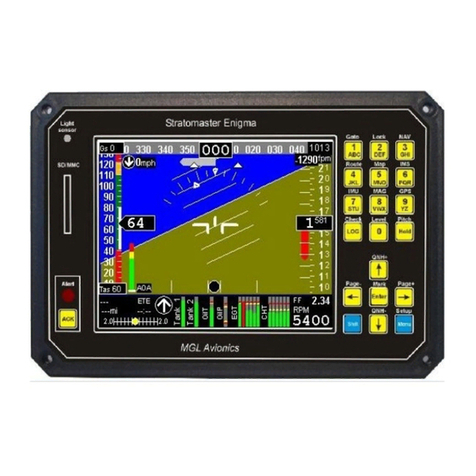
MGL Avionics
MGL Avionics Stratomaster Enigma manual
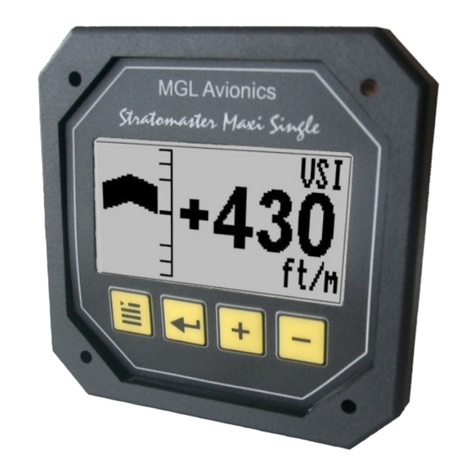
MGL Avionics
MGL Avionics Stratomaster Maxi Single VSI-2 instructions

Planar
Planar LC-3ATI Specifications
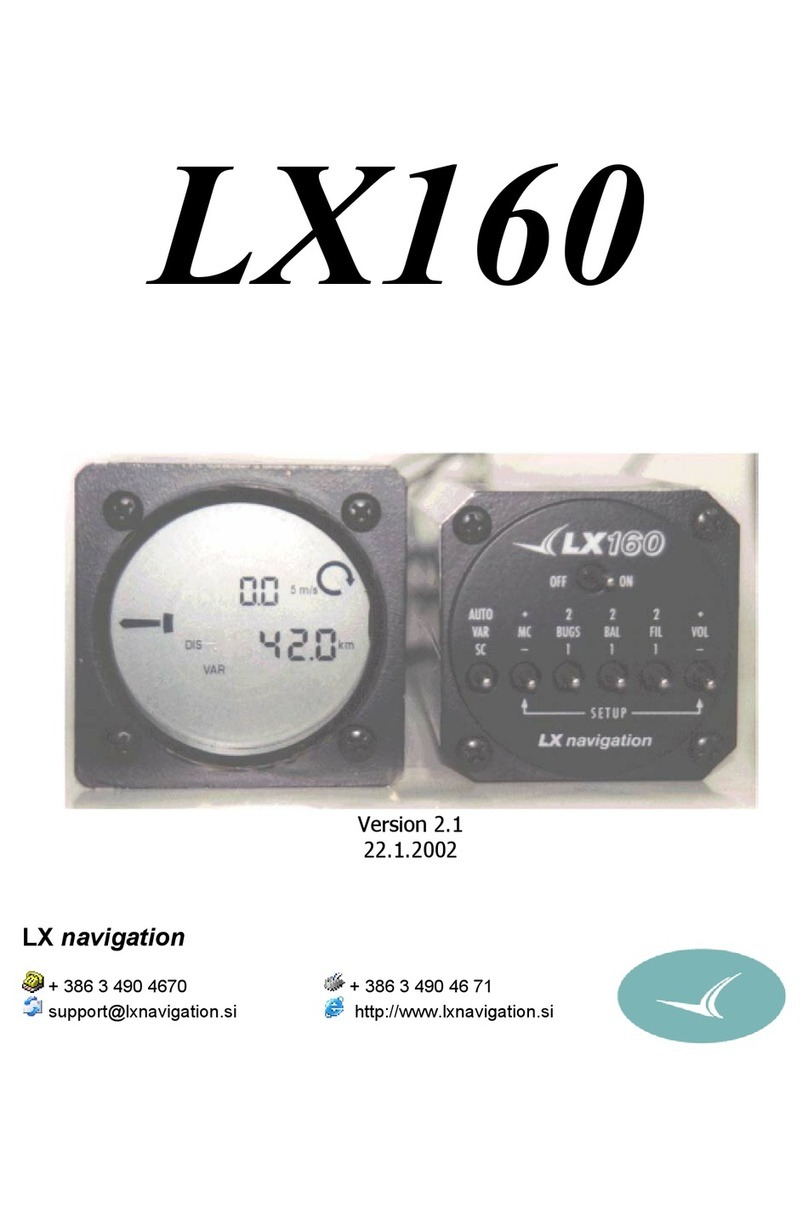
LX Navigation
LX Navigation LX160 manual
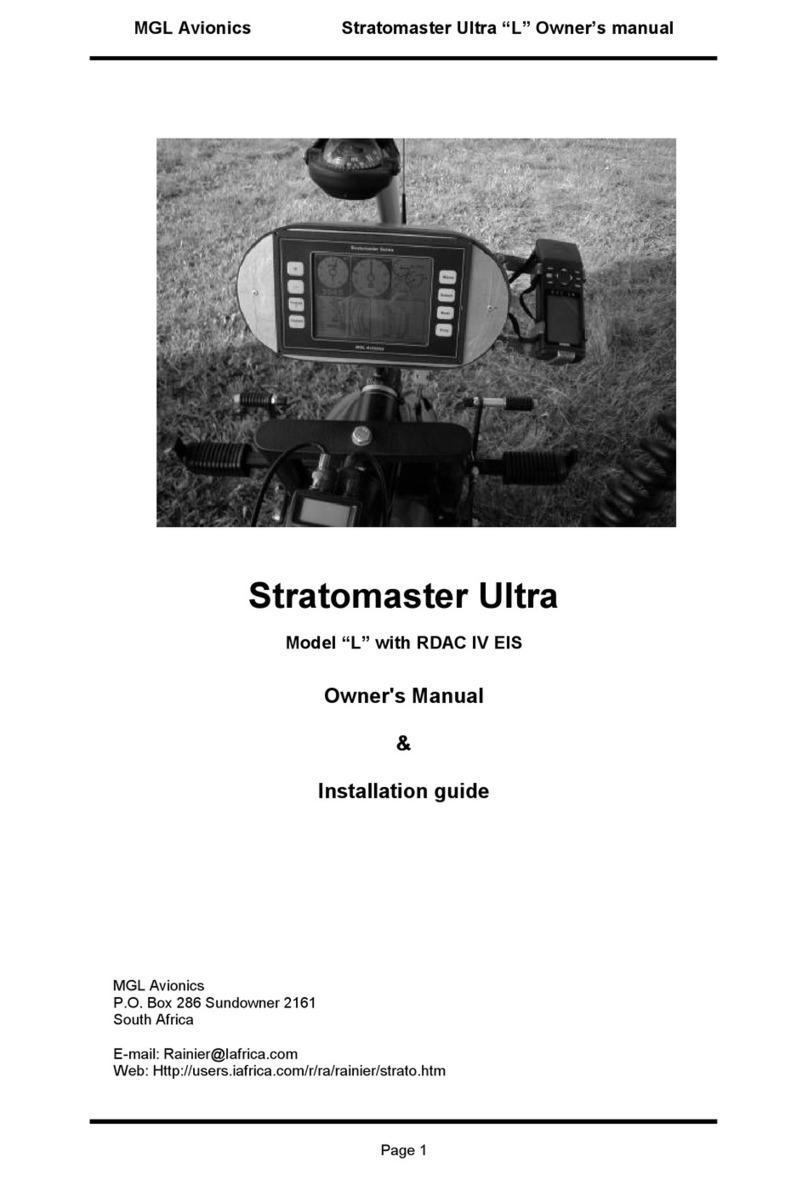
MGL Avionics
MGL Avionics Stratomaster Ultra L Owner's manual & installation guide
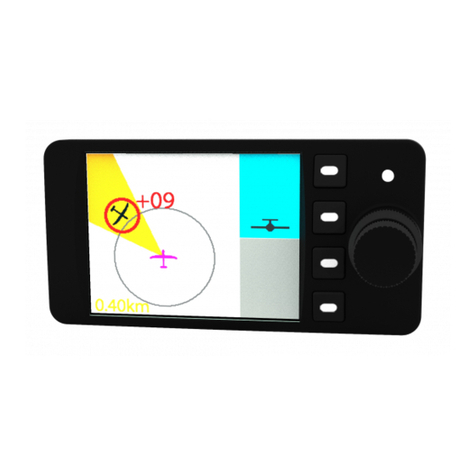
air avionics
air avionics ATD-11 installation manual
